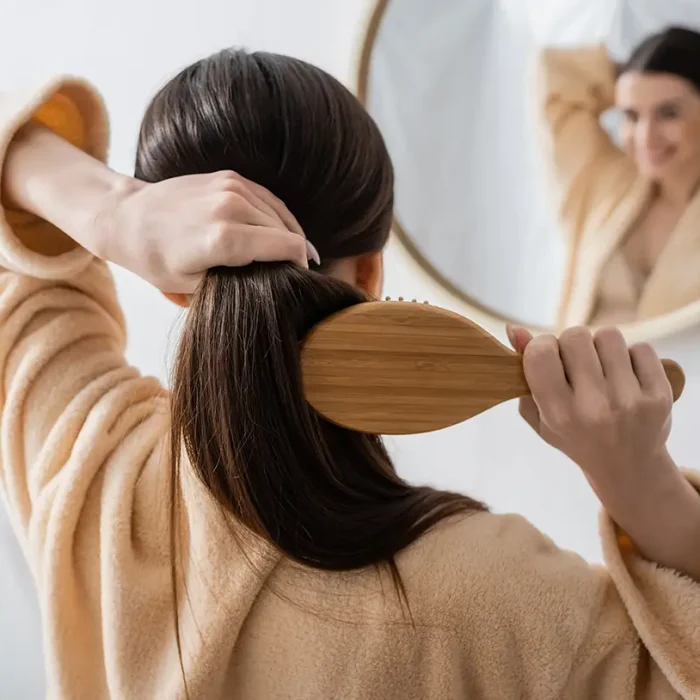New baby, new routine—and suddenly new hair in the brush, shower, and on the burp cloth. If you’re searching for postpartum hair loss solutions in Cleveland, you’re not alone. Up to 50–60% of new moms experience postpartum telogen effluvium—a fancy name for temporary shedding triggered by hormonal shifts after delivery. The good news: with the right plan, you can calm the shed, support regrowth, and restore fuller-looking coverage while keeping your schedule—and your scalp—sane.
At NüIQ Wellness Lounge & Med Spa, we specialize in non-surgical, medically guided hair restoration that fits real life: PRF (Platelet-Rich Fibrin), MOXI® scalp rejuvenation, PDGF-supported signaling, Nutrafol® Postpartum, and plated.™ Hair Serum—sequenced and measured so you can see progress, not guess.
What Happens to Your Hair After Pregnancy?
During pregnancy, high estrogen levels hold hairs in the growth phase (hello, volume and shine). After delivery, estrogen drops, and a large number of hairs shift into the shedding phase together—usually 8–16 weeks postpartum, with a peak around the 4th month. This synchronized shed can look dramatic, but it’s usually temporary.
Typical arc (everyone’s different):
- Weeks 8–16 postpartum: Shedding “turns on”
- Months 4–6: Peak shed; ponytail feels thinner, part looks wider
- Months 6–12: Gradual return toward baseline with the right care
- Beyond 12 months: If shedding persists or you see patchy loss, get evaluated
When to Get Checked First
Before we build your restoration plan, we’ll screen for correctable contributors that might be amplifying shedding or delaying regrowth. These include:
- Iron/ferritin status, thyroid function (TSH/free T4)
- Vitamin D, B12, zinc, and overall nutrient intake
- Distinguishing postpartum telogen effluvium from alopecia areata, scalp psoriasis/seborrheic dermatitis, or scarring conditions
If something needs a dermatologist’s or your OB-GYN’s attention, we’ll coordinate to make sure you’re getting full-spectrum support.
The NüIQ Postpartum Hair Restoration Framework
Think of your plan as four engines we sequence for momentum—with minimal downtime and maximum compatibility with a new-mom schedule.
1) Signaling: PRF (Platelet-Rich Fibrin)
We use a small sample of your blood to create PRF—a concentrate of platelets and growth factors in a fibrin matrix. Injected into thinning zones, PRF supports follicle vitality, microcirculation, and tissue repair signaling to help miniaturized hairs perform better.
What moms notice: Shed calms first (often by weeks 6–12), then coverage and feel improve across months.
2) Environment: MOXI® Scalp Rejuvenation
MOXI® is a gentle, non-ablative fractional 1927 nm treatment that refreshes scalp quality and helps stimulate regrowth by activating the body’s wound-healing cascade. Ultra-controlled micro-thermal zones can:
- Encourage pro-growth signaling (supporting pathways like VEGF/PDGF/FGF)
- Enhance microcirculation and oxygenation around follicles
- Improve topical absorption for PRF applied immediately after injections and plated.™ Hair Serum
- Smooth scalp buildup and balance oil for a cleaner, calmer environment
Who’s a candidate? In our experience, most postpartum women—across hair textures and skin tones—do well with carefully tailored settings.
3) Inside-Out Support: Nutrafol® Postpartum
Formulated for the postpartum and breastfeeding period, Nutrafol® Postpartum targets hair wellness factors like stress, nutrient demands, and hormone shifts with ingredients chosen for this season of life. Consistency for 3–6 months supports less shedding and fuller-looking hair. (Always review supplements with your provider.)
4) Consistency Between Visits: plated.™ Hair Serum
This platelet-inspired growth-factor serum reinforces results between appointments. Used regularly—especially when we time MOXI® to improve absorption—it can help reduce shedding, improve the appearance of density, and keep the scalp balanced.
A Realistic 24-Week Hair Restoration Plan for New Moms
Baseline (Week 0)
- Photos (front, crown, part line) under consistent lighting
- Part-width measurement + simple pull test
- Start Nutrafol® Postpartum daily and plated.™ most evenings
- Gentle scalp routine: wash cadence optimized, heat limits, loose styles
Week 2–3: Momentum On
- PRF #1 + MOXI® (same day or same week)
Week 6–7: Stack the Signals
- PRF #2; continue Nutrafol® Postpartum + plated.™
- Expect calmer scalp and fewer hairs in the brush/shower
Week 10–11: Add Lift
- PRF #3 + optional MOXI® boost
- Re-photo; look for less crown “glare,” tighter-looking part, stronger root “grip”
Week 14–16: First Progress Check
- Side-by-side photos, part-width re-measure, pull test
- Map maintenance every 3–6 months
Week 20–24: Consolidate
- Maintenance cadence begins (PRF ± MOXI®)
- Nutrafol® Postpartum continued, plated.™ steady
- Adjust scalp routine for the next season
Many new moms see shed reduction by weeks 6–12 and coverage/volume improvements through weeks 12–24+. The secret isn’t a single appointment; it’s the sequence and consistency.
Styling & Scalp Care That Won’t Sabotage Progress
- Loose, low-tension styling: Skip tight buns/ponytails that stress fragile hairs
- Heat hygiene: Lower temp, fewer passes, heat protectant always
- Volumizing haircut strategy: Micro-layers around the part and crown reduce visible scalp
- Microfiber towel + gentle detangling: Handle wet hair like silk
- Shampoo strategy: Keep scalp clean; switch to light conditioner from mid-shaft down
Real-World Postpartum Scenarios (Composite Illustrations)
The Ponytail Test (Female, 32)
Problem: Ponytail feels half its size at 4 months postpartum.
Plan: PRF x3 over 11 weeks, MOXI® twice, Nutrafol® Postpartum + plated.™ nightly.
Checkpoint: Shed settled by week 8; ponytail circumference and part-line photos improved at week 16.
The Crown Camera Shy (Female, 36)
Problem: Ring-light exposes crown glare on Zoom at 5 months postpartum.
Plan: PRF x3, early MOXI®, strict heat limits, volumizing cut.
Checkpoint: By week 12, less glare in standardized photos; hair felt sturdier.
(Examples are composites to illustrate the process; individual results vary.)
Postpartum Hair Loss FAQs
Is this safe while breastfeeding?
PRF uses your own blood, and Nutrafol® Postpartum is designed for this period. We personalize plans and encourage you to discuss supplements and timing with your OB-GYN or primary provider.
How will I know it’s working?
We show you—photos, part-width measurements, and a pull test—so progress is visible and objective.
Will I need this forever?
Most moms transition to maintenance every 3–6 months after the initial build phase. Your plan scales with your season of life.
Can I still consider a hair transplant later?
You can—but many postpartum cases normalize with the right non-surgical plan. If you ever explore surgery, you’ll have optimized the scalp first.
The NüIQ Difference for New Moms
You don’t need a day off work—or a day away from your baby—to start feeling like yourself again. NüIQ’s postpartum hair restoration is low-downtime, structured, and measured, blending clinic-level tools with a schedule you can sustain. We don’t hand you a “treatment.” We hand you a plan—and walk it with you.
Ready for your postpartum hair restoration consult in Cleveland?
Let’s calm the shed, build coverage, and bring back your hair confidence—on a timeline that respects your life right now.
NüIQ Wellness Lounge & Med Spa — Contact & Location
5450 Detroit Ave, Cleveland, OH 44102
(216) 377-1778
info@nuiqwellness.com
nuiqwellness.com
Instagram: @nuiqwellness
Medical disclaimer: This content is educational and not a substitute for medical advice. Individual results vary.



